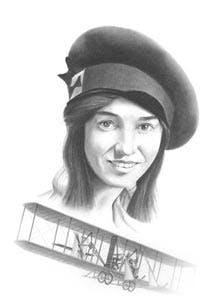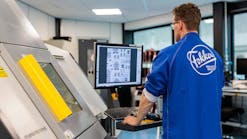“The name “Katherine Stinson” on a program was sure to draw a crowd. In spite of the publicity generated by her daring feats, she was known in the flying community, especially among the mechanics, as a sane flier who was meticulous about maintenance.”
— Eileen F. LeBow, Aviation Author, “Before Amelia”
Aviatrix Katherine (“Katie”) Stinson was the first woman sky-writer, first woman to loop the loop, and first woman to fly in Canada, Japan, and China. She flew day or night and set distance records. Her stunts were death-defying as she pushed herself and her aircraft to extreme limits. She never had a severe crash much less a fatal accident. She suffered little or no discrimination as a female flier. Although she was sensational, she was not controversial, and although her exhibition flying career was dramatic, it was not traumatic. Her path was a linear series of successes, reducing the odds against her by being involved with the maintenance of her machines like no other woman flier before her. She sought out and was approached by the best mechanicians at the aerodromes for overhaul and repair. She was pleasant to work with and paid fair salaries, contributing to the struggling commerce of aviation. She probably hired dozens of mechanicians in the United States, Canada, Europe, and Asia. Many were famous fliers or later flew the U.S. mail — others remain obscure or unidentified. Although diverse, all were similar in one respect — to work for “Katie” Stinson you had to be the best.
Katherine (“Katie”) Stinson was born, Feb. 14, 1891, in Alabama, the first of four children followed by Edward, Marjorie, and John (“Jack”). Their parents Emma and Edward Sr. amicably separated and Emma raised her very young brood alone, with progressive, liberal guidance. Later in life, Katherine recalled her childhood had few restrictions or conventional “rules” separating boys from girls. An entrepreneurial businesswoman, Emma prepared all of her children to be self-supporting. She moved her family to Arkansas, where Katherine did well in school, showing an aptitude in music in her teens, with aspirations of becoming a concert pianist or instructor.
Even with Emma’s support, so the family story is told, Katherine’s goal required funds she did not have. Caught up in the nation’s new “air mindedness” Katherine found a profession and a passion in flying which paid her more for one flying exhibition engagement than many Americans made in a year.
Independent entrepreneur
At age 19 Katherine had little trouble gaining Emma’s support to finance flying lessons from Max Lillie at Cicero Field near Chicago, and purchase her first aeroplane. Convincing Lillie to take her on as his first and only female student was typical of Katherine’s resolve and Southern charm. With three weeks of instruction, she mastered the controls and passed her flying tests for the Aero Club becoming the fourth licensed female aviator in the United States on July 24, 1912. Instead of flying with a team, Katherine followed her mother’s lead as an independent entrepreneur. She incorporated herself as the Stinson Aviation Company, charging a fee to see her fly, and immediately became, as author Eileen LeBow phrased it, “an aerial superstar.”
Watching from the airfield below were three siblings eagerly anticipating their turn to enter “the aviation game.” With blurred if not invisible lines separating them by gender each was a tinkerer, good with designing and building something with their own hands. While in grammar school, Marjorie and Eddie fashioned a (nonfunctional) aeroplane out of bed sheets and wood, talents which later became obvious in their aircraft designs. As the youngest, Jack was “the helper” in family chores, absorbing the skills he needed to start the Stinson Aeroplane Company at Ohio in 1920.
Some of the world’s most famous fliers built, maintained, tested, and flew their monoplanes and biplanes at Cicero Field and later at nearby Ashton Field. Among them, Katherine stood out as “different” but from the onset gained respect, if not admiration. Her peers were male aviators and mechanicians; some were naïve and reckless. Some were too poor to properly maintain their aircraft. Katherine was none of that. She gained a reputation for meticulous attention to the care of her machines. LeBow describes her first aeroplane in 1913, a used and modified Wright “B” with a Wright engine:
“The aeroplane was covered with layers of dirt and oil. Katherine took the machine apart and cleaned it up, examining every part. She noted that there were a lot of crossed wires that were beginning to rub . . . She removed all the old wires and put in new ones . . . The men on the field ribbed her for her careful scrubbing . . . but when she had finished, the machine looked like new, and it was airworthy . . . All of her flying career, Katie insisted on a well-kept aeroplane.”
“Little Katie Stinson’s” fee for an exhibition flight rose to a thousand dollars. To keep her performances in demand she continually added new stunts. In 1915 she learned two “air-circus” aviators had “looped the loop” earning huge salaries, and announced she would do the same. Her 5-foot 5-inch, 101-pound frame was packed with coordination and strength, and she conquered the “loop” in 1916. She added consecutive loops, “dippy twists,” and invented a crowd pleaser billed as the “Wright Tango.” She taunted male fliers in good-natured competition and once said she was “lonesome” and wished other girls would fly too. She demonstrated bomb drops (using flowers), made low level flights, and raced her aircraft against automobiles. She affixed light bulbs and flares to the wings which glowed as she “wrote” her initial in the night sky.
She dropped toys and candy from the air to children, and distributed pamphlets for suffragette causes and for the Red Cross.
By 1914, sister Marjorie had completed training at the Wright School of Flying in Ohio and became the ninth woman in the United States to earn her license. She was 19 when she joined her sister on the flying circuit. Eddie later earned his license, endearing himself to the public as the “Dean of the Air.” He was also considered an excellent mechanician and worked for Katherine early on, as did O.H. “Bud” Snyder who later designed light aircraft, Rudolph W. “Shorty” Schroeder, Richard E. Wagner, and others who made routine repairs and overhauls.
Not all of Katherine’s repairs were routine. Air show spectators could be rowdy, if not violent, when a promised exhibition flight was cancelled, no matter what the cause. Katherine defied weather and equipment failure, once telling a reporter, “The people expect me to fly, and I never fool them.” At Winnipeg, Canada, she was billed as the star attraction for an evening performance with magnesium flares attached to her wings for sky writing. Her mechanician, W.F. “Shorty” McGuire was assembling her biplane when a sudden storm enveloped their camp. High winds tossed a 200-pound lid off one of the crates in which the tail was packed and smashed into the wings. Katherine assured a reporter that she and McGuire would have it repaired overnight. “I have been carrying the extra wings with me all season,” she drawled, “and now I have occasion to use them.”
Stinson flying school
With the Great War imminent in 1915, Katie’s family opened the Stinson School of Flying at San Antonio, TX. Its first students were from Canada and the U.S. 1st Aero Squadron. Exhibition work kept Katherine on the road, while Marjorie, and later, Eddie, became instructors. Eddie doubled as a mechanician joining Richard Hand, Dan Kiser (and later, Robert F. Shank). Jack helped his mother, Emma, who he once described as the “mainspring” of the school business. Stinson School of Flying relocated to Illinois and closed when all civilian flying ceased during WWI.
Katherine flew a variety of aircraft, adjusting quickly to increased horsepower affixed to machines modified for aerobatics. Tired of cold air, bugs, and wind-burned skin, Katherine was ready for an enclosed cockpit. In 1915 she sketched her requirements for a custom exhibition biplane, which was skillfully designed by Walter Brock of the Partridge-Keller Aeroplane Company in Chicago. It was powered by the 80-hp Gnome engine used on the fatal flight of America’s most famous male stunt pilot, Lincoln Beachey. Another aviator may have hesitated for fear it carried bad karma, but not Katherine. Apparently not superstitious or overtly religious, LeBow observed Katherine had “no reliance on anything but a well-maintained machine.”
“Flying Schoolgirl”
Hundreds of thousands of spectators in the United States, Canada, and Europe gasped with delight watching the “Flying Schoolgirl,” and she was a virtual phenomenon while touring Japan and China in 1916-1917. She created a frenzy of mass adulation, inspiring thousands of women to expand their confining social roles. Frequently photographed wearing a kimono standing next to her aeroplane, the Japanese called her the “Air Queen.” Mechanician Frank Champion (and Emma) traveled with her among crates of aircraft, parts, equipment, maintenance tools, and gifts. She flew her Partridge-Keller, and a spare Laird biplane. (When the Laird’s 60-hp Anzani needed repair, Champion substituted a 50-hp Gnome.)
Katherine and Marjorie both volunteered but were denied to fly for the all-male U.S. Air Corps during WWI. Katherine briefly flew the mail in an aircraft combining three different Curtiss models affectionately referred to as “the junkyard hybrid” with a 90-hp OX2 engine. Toward the end of the war, Katherine drove an ambulance for the Red Cross in Europe. Back home she successfully battled years of tuberculosis.
In 1928 she married Michael Otero Jr. and became a professional architect, living in Santa Fe, NM, until her death in 1977 at the age of 86.
She was remembered years later by Edith Culver who encountered her in 1916 at an air meet:
“Katherine Stinson was a surprise to me. I suppose I expected her to be mannish. Instead, she was something quite the opposite, fragile and dainty. Her friendliness and soft refined voice masked unbounded endurance and courage. She was a brunette version of Mary Pickford with long chestnut curls . . . She was America’s sweetheart of the airways at that time as surely as Mary Pickford was America’s sweetheart of the silent screen.”
When she was not wearing flying gear, or posing in kimonos, Katherine Stinson was shoulder to shoulder with her mechanicians in coveralls. In awe of her contributions to aviation, pioneer aircraft designer William Stout wrote, “She had done it all.”
Giacinta Bradley Koontz is an aviation historian and author. She was the founder and director of the Portal of the Folded Wings Shrine to Aviation and Museum from 1995-2001 (the site of Charles Taylor’s grave in North Hollywood, CA). Giacinta holds a BA in anthropology with a minor in U.S. history and has given presentations on pioneer aviation since 1995. Most recently she has been awarded a partial grant from the Wolf Aviation Fund to write her second book, highlighting the life of Amelia Earhart’s mechanic, Ernest Eugene Tissot Sr.





